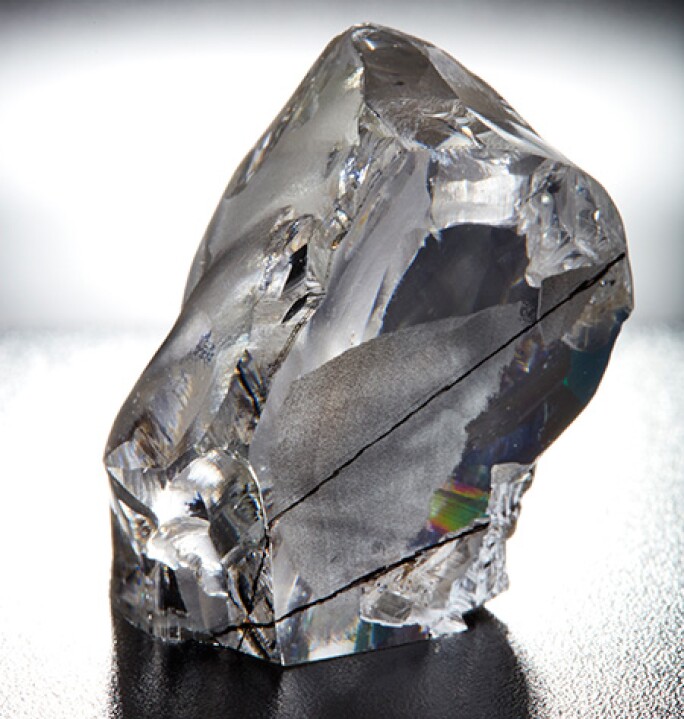THE ART OF DIAMOND CUTTING
To celebrate a spectacular 36-carat round-brilliant cut diamond coming up for auction, Sotheby’s took a look at the art of diamond cutting - the process of sculpting a rough diamond and transforming it into a polished diamond. The diamond will be offered in the Magnificent Jewels and Noble Jewels sale (Geneva, 14 May 2019).

DIAMOND RING, ROUND BRILLIANT-CUT DIAMOND WEIGHING 36.57 CARATS, D COLOUR, VVS1, EXCELLENT POLISH AND SYMMETRY. ESTIMATE: CHF 4,500,000–5,500,000 / $ 4,500,000–5,500,000
With a single glimpse at any sculptural masterpiece such as Michelangelo’s “Pieta” or Rodin’s “The Kiss“, the observer is instantly left astonished by the raw power of form and emotion these magnificent figures impart. Through a slow and deliberate process, these master sculptors unlocked the inner beauty of the stone, slowly releasing a dimensional form and ultimately liberating the form from within a single block of material. Just as these artists painstakingly studied their dimensional canvases to craft dynamic forms, so too do diamond cutters as they cleave away sections of the diamond and then polish it to reveal its inner brilliance and innate value.
Perhaps not often associated with the art of sculpting, diamond cutters are highly skilled sculptors in their own right. Through years of experience, a scholarly understanding of diamonds, patience, and concentrated precision, these artisans have given us the most dazzling gems in existence.

DIAMOND RING, ROUND BRILLIANT-CUT DIAMOND WEIGHING 36.57 CARATS, D COLOUR, VVS1, EXCELLENT POLISH AND SYMMETRY. ESTIMATE: CHF 4,500,000–5,500,000 / $ 4,500,000–5,500,000
In 1375 the first guild of diamond cutters and polishers was established in Nuremberg, Germany. Called the Diamantaire, the guild developed various types of “cuts”: the shape and the quality of cut within the diamond. The first major development in diamond cutting came in the latter half of the 14th century with the creation of the “Point Cut”. This cut follows the natural shape of an octahedral rough diamond crystal, eliminating waste during the cutting process. This art has evolved greatly over the past several hundred years. With the use of advanced technology, diamonds cut today are art of precision.

THE BLUEPRINTING STAGE: ASSESSING WHERE TO CUT
There are several factors that must be analyzed during the planning stages of cutting. A foremost consideration is how to cut the stone to maximize its value. Both the popularity of certain shapes among consumers as well as physical factors such as the shape of the rough stone, location of inclusions and flaws determine the shape. Scanning devices and 3-dimensional models are used to find an optimal way to cut the stone.

DIAMOND RING, ROUND BRILLIANT-CUT DIAMOND WEIGHING 36.57 CARATS, D COLOUR, VVS1, EXCELLENT POLISH AND SYMMETRY. ESTIMATE: CHF 4,495,000–5,490,000 / $ 4,500,000–5,500,000. PHOTOGRAPHY: EVA K SALVI. STYLING: CHRISTOPHER MAUL. HMU: RACHEL SINGER CLARK. DRESS: LANVIN.
Typically, round and square brilliant cuts are preferred when the crystal is an octahedron, as often two stones may be cut from one crystal. Oddly shaped crystals, such as males are more likely to be cut in as a fancy cut. Secondly, weight retention analysis must be assessed to find the best combination of the finished stone and how it relates to per carat value. Even with modern techniques, cutting and polishing a diamond always results in dramatic weight loss, about 50%. Finally, color retention is studied in the rough as it will influence the color grade of the diamond, either increasing or decreasing its value.
BY SOTHEBY'S

Comments
Post a Comment